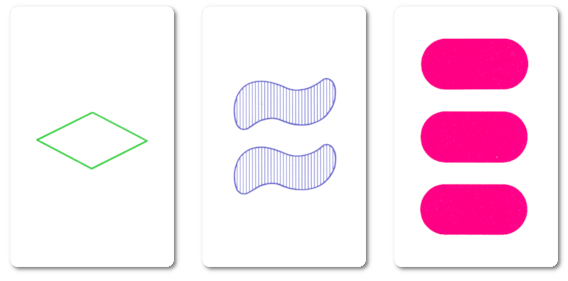Type Real time Cards 81 | Players 1+ | |
 | ||
Skills required Visualization, logical reasoning, ability to focus | ||
Set is a real-time card game designed by Marsha Falco in 1974 and published by Set Enterprises in 1991. The deck consists of 81 cards varying in four features: number (one, two, or three); symbol (diamond, squiggle, oval); shading (solid, striped, or open); and color (red, green, or purple). Each possible combination of features (e.g., a card with three striped green diamonds) appears precisely once in the deck.
Contents
History
The game evolved out of a coding system that the designer used in her job as a geneticist. Set won American Mensa's Mensa Select award in 1991 and placed 9th in the 1995 Deutscher Spiele Preis.
Games
Several games can be played with these cards, all involving the concept of a set. A set consists of three cards satisfying all of these conditions:
The rules of Set are summarized by: If you can sort a group of three cards into "two of ____ and one of ____", then it is not a set.
For example, these three cards form a set:
Given any two cards from the deck, there is one and only one other card that forms a set with them.
In the standard Set game, the dealer lays out cards on the table until either twelve are laid down or someone sees a set and calls "Set!". The player who called "Set" takes the cards in the set, and the dealer continues to deal out cards until twelve are on the table. A player who sees a set among the twelve cards calls "Set" and takes the three cards, and the dealer lays three more cards on the table. (To call out "set" and not pick one up quickly enough results in a penalty.) It is possible that there is no set among the twelve cards; in this case, the dealer deals out three more cards to make fifteen dealt cards, or eighteen or more, as necessary. This process of dealing by threes and finding sets continues until the deck is exhausted and there are no more sets on the table. At this point, whoever has collected the most sets wins.
Variants were included with the Set game that involve different mechanics to find sets, as well as different player interaction. Additional variants continue to be created by avid players of the game.
